Deadly Serious
Revised 12/3/25 added two photos
In previous postings we discussed the public health issues that drove and shaped organized nude male swimming. The prevalence of infectious diseases from natural water sources was a serious concern. However, at the turn of the 20th century it was recognized that one of the leading causes of death among adolescent and teenaged boys was drowning.
That fact was nothing new, it had been recognized for centuries. In warmer weather boys had a tendency to seek out aquatic diversions wherever they could find them. Creeks, mill and farm ponds, lakes, rivers, reservoirs and abandoned quarries were fair game. Uniformly, these recreations were undertaken by non-swimmers out of the sight of adult supervision. A boy who ventured out over his depth or was caught up in a current would likely become a victim.
As the new century dawned, private organizations and municipalities nationwide came up with an ambitious plan: teach boys to swim en masse. In this posting we will examine the photographic evidence of the grass roots public response to this societal need.
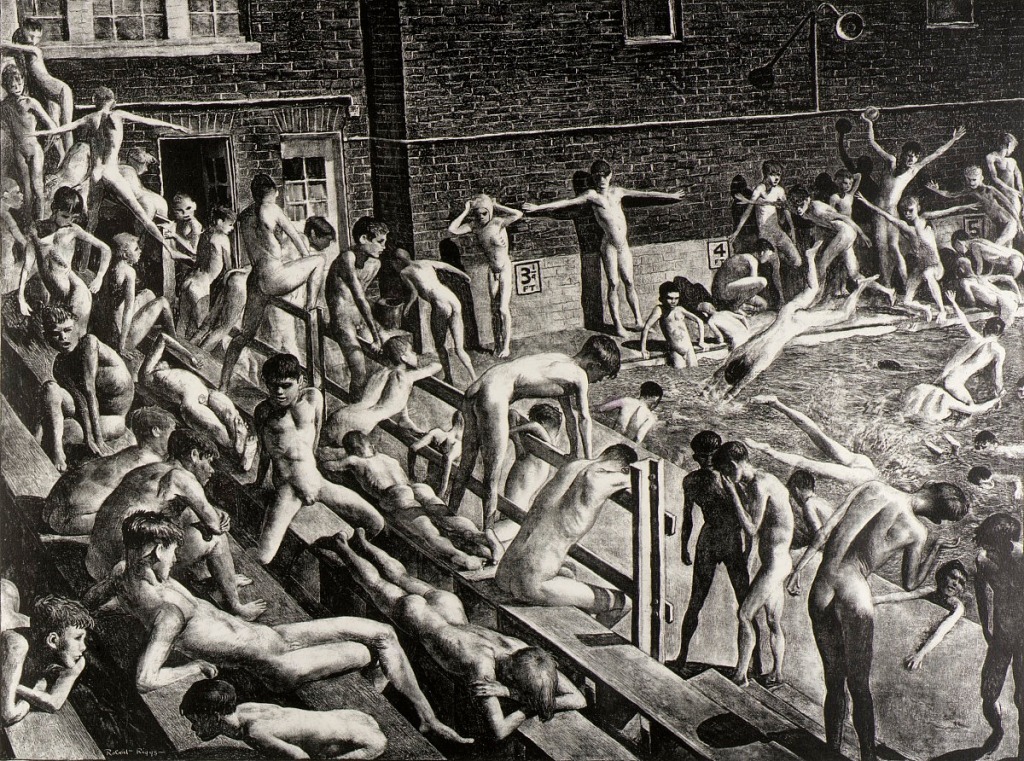
Accomplishing this plan would require three key ingredients: Facilities, organizations and publicity.
In this case, facilities meant pools. The image above is an unusual example. It is a rendering of typical activities that occurred in the outdoor pool at the Germantown Boys’ Club (Philadelphia, Pennsylvania). It is a lithograph by Robert Riggs titled “Pool” and dated 1933. Copies are held by the Smithsonian Institution and the Metropolitan Museum of Art.
An undated photographic perspective of this pool is shown below.
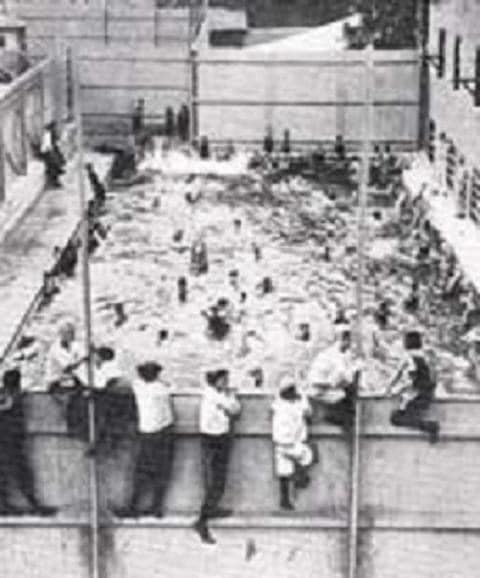
Given the circumstances (nudity) depicted in the artwork, the tall privacy fence is understandable. Based on the attire of the on-lookers (knee pants and stockings called “knickers” that went out of fashion during the 1940’s), this photo is probably more or less contemporaneous with the lithograph.
The outdoor location is what made this facility unusual. Most urban private clubs (YMCA, Boys’ Club or gentlemen’s athletic clubs) had indoor pools for year ‘round use. Many municipalities and neighborhood clubs (the latter still a fixture in suburban communities) maintained outdoor pools, but these were usable only seasonally.
Be that as it may, the first two requirements blended into a single solution. The clubs had both the facilities and the organization to carry out the program. The YMCA and the Boys’ Clubs had networks that spanned the country and existed in most communities. Utilizing these types of organizations allowed the program to be undertaken independently on a location-by-location basis at minimal cost. They were a natural choice.
The efforts were augmented by other resources such as schools and municipal governments. Below is an example of these.
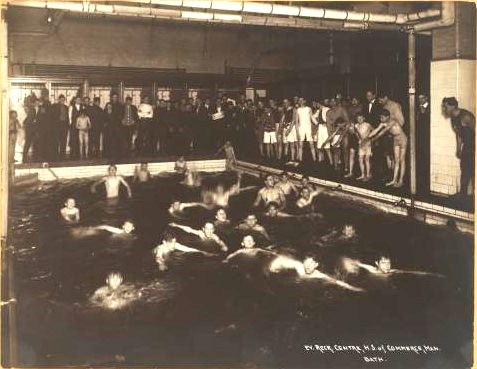
This rather dark image was made in 1905. In this posed shot, both the suited kids on the deck and the swimmers are demonstrating their form. The truth of the matter, however, is indicated by the dry boys on the left of the image. They confirm that this is a nude event. You leave your trunks behind when entering the water.
It should be noted that this photo predates any circulating filtration or chemical treatment. This “tank” was maintained by periodically draining the water and scrubbing the sides and bottom before refilling.
At this point, we return to the third requirement for an effective program: Informing the public (aka “publicity”). The public was offered swimming lessons to boys for little or no cost. With volunteer labor, swimming lessons were made available in a manner and on a scale similar to a mass vaccination program. That was an apt analogy since it effectively immunized boys – and eventually girls – against drowning.
Several images of boys’ swimming classes have already been presented in previous postings – albeit in among other topical photos. In this posting, we concentrate on the training of pre-pubescent boys. As can be seen, the universal practice was: instructors with suits, students without.
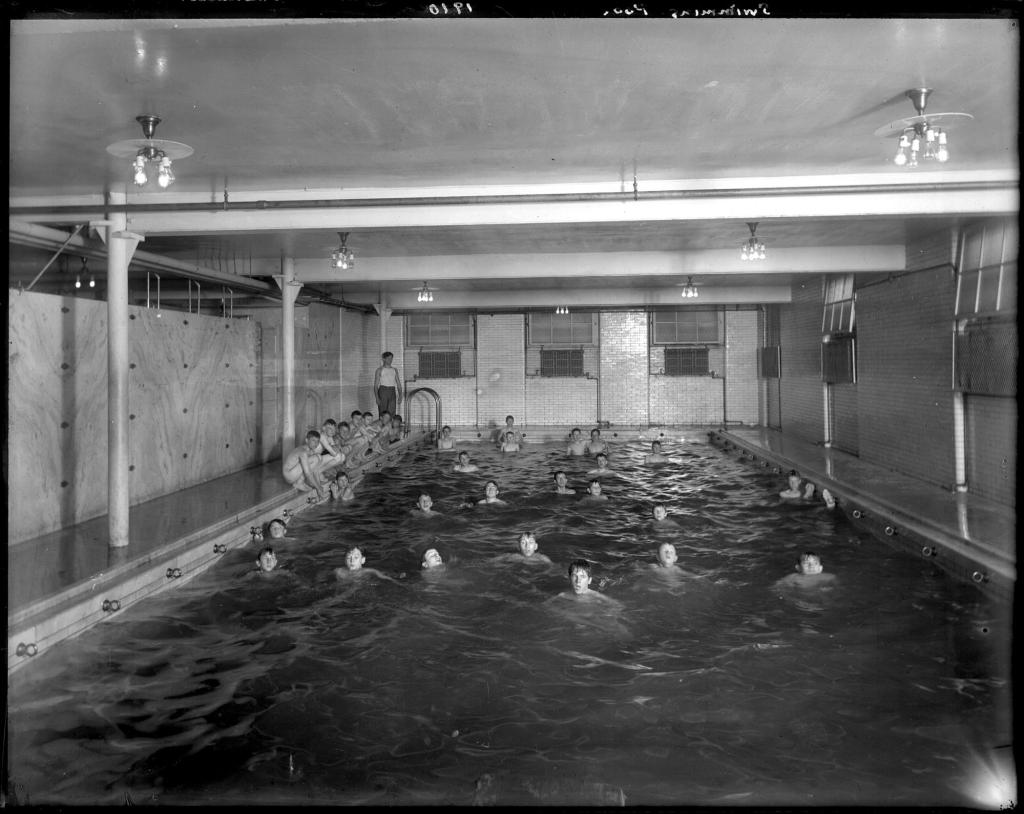
This class picture is a bit more modern. It dates to 1910. The quaintness of the setting and the appointments speak for themselves. Note that the instructor is in street clothes with only his “wife beater” undershirt as an accommodation with the undoubtedly warm, humid environment. You may recall our previous observations concerning the pre-1920s practice of the instructors typically arrayed street clothes rather than swim suits. The comfort of the boys is not in doubt, dressed as they are in only their skins.
This image is from a private non-profit Virginia archive called The Valentine. It is accredited to the American Alliance of Museums. The photo is attributed to Cook Studio and was printed from a glass negative! Talk about going back a ways …
Individual photos like this probably didn’t get wide circulation. Ditto for the next few shots.
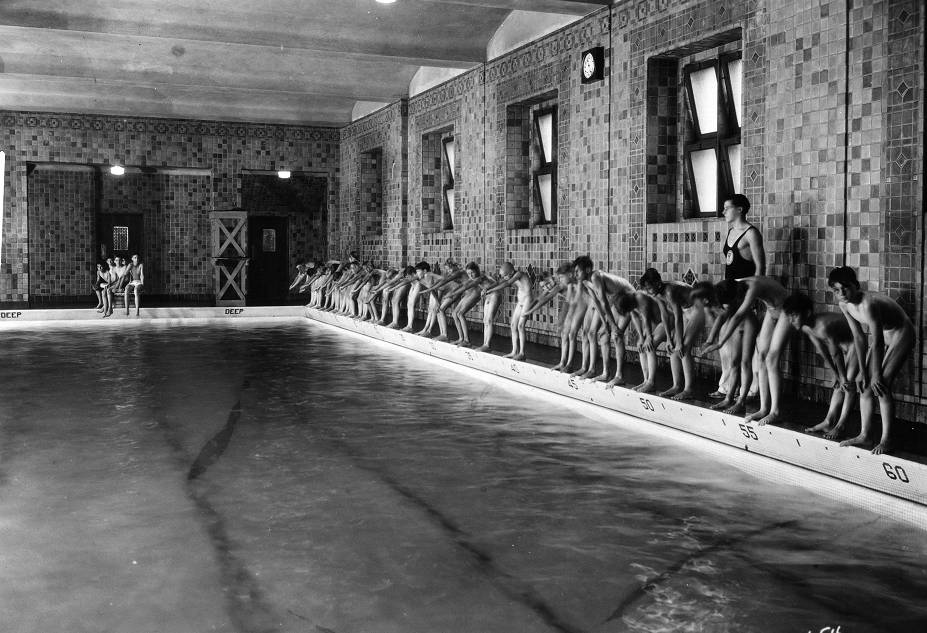
This revealing picture of a swim class is undated, but research shows that this facility was opened in 1926. This may be a promotional shot from around that period. The anomaly is that the guy-in-charge is attired the same as in the 1910 image above. In other pictures from this period, the instructor is in a swim suit. Although the boys in the class are undoubtedly nude, the (older?) on-lookers perched on the diving board are suited.
This image is from the Missouri State Historical Society digital archives.
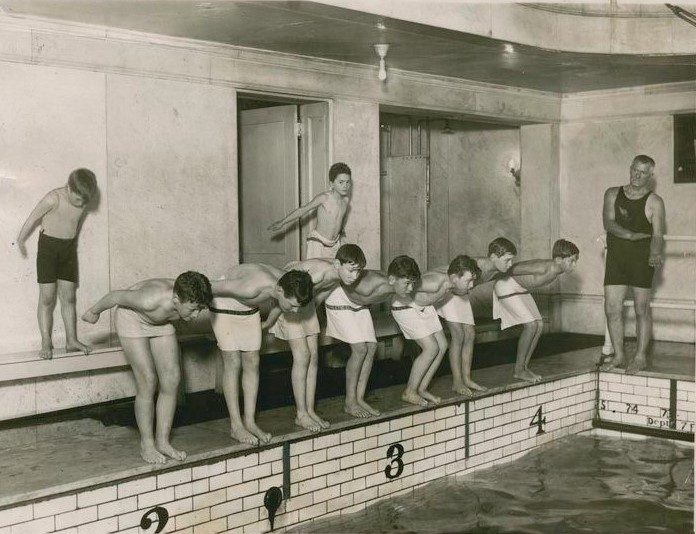
This otherwise unattributed image is from the NYC Public Library Digital Collections. The section of the collection to which this photo belongs says that it spans from 1860 to 1920. I would think this photo dates to somewhat after 1920. The boys have temporarily wrapped themselves in towels to protect their modesty as they take a racing dive pose.
Note that the pool contains only four swimming lanes. This was typical of indoor pools of this period which were narrow due to structural limitations.
By the 1920s newspaper articles started being used for widespread announcements of swimming class availability.
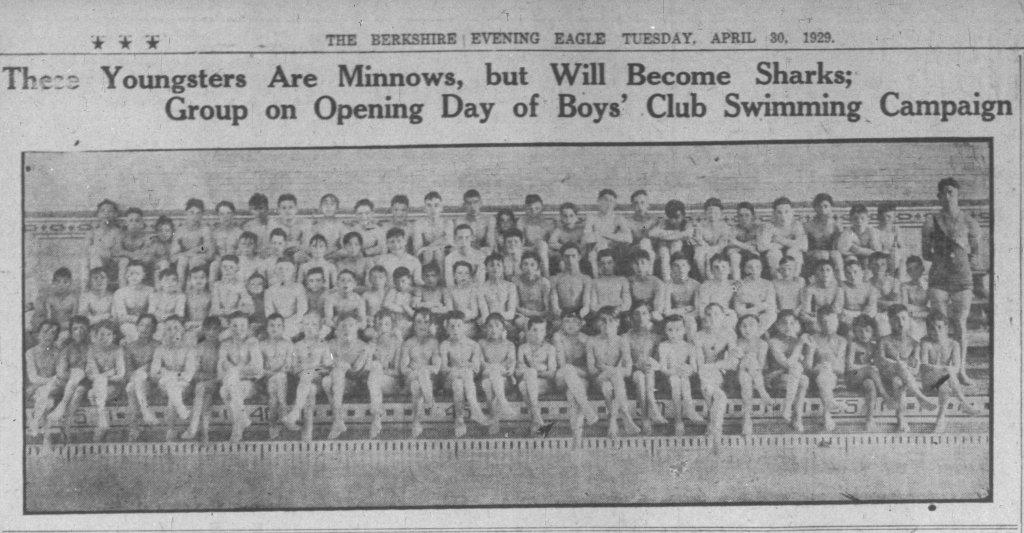
We’re in Pittsfield, Massachusetts on April 30, 1929. Note the use of the term “campaign” in the title. That picks up the theme highlighting the urgency and scale of the nationwide effort.
This carefully posed publicity shot is intended to alert the public to the availability of the Boys’ Club learn-to-swim program. This website has presented several of these massed class images depicting scores of students apparently shepherded by one instructor. One hopes that in practice the class was broken into smaller groups and/or had multiple assistant instructors.
The discipline of the nude boys keeping their legs firmly crossed (not a natural act for a young boy) is laudable.
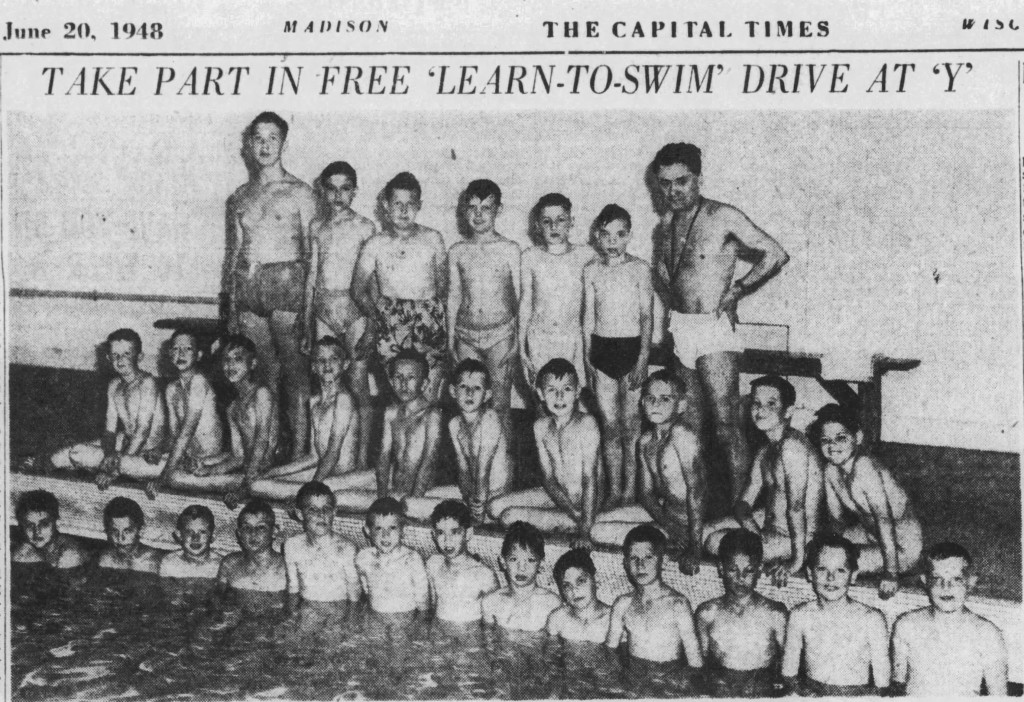
In Madison, Wisconsin in 1948, the YMCA learn to swim program was called a “drive.” This conveys the sense of canvassing neighborhoods to draw out potential students. The judicious posing of the unsuited boys on the deck accomplishes the aim of keeping the boys’ “privates” out of public view. Of course, you can never eliminate the one tell-tale bare buttock on the end of the row.
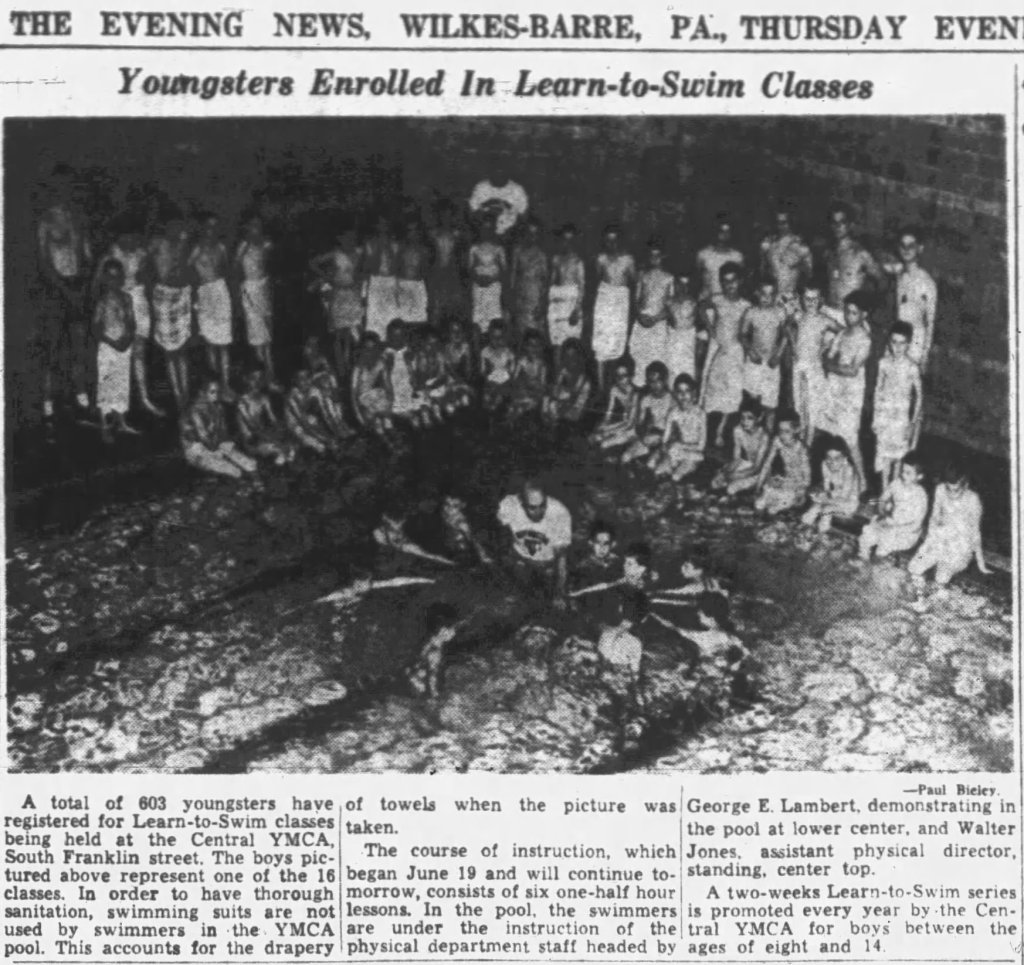
The article in the June 29, 1950 Wilkes-Barre Evening News did not lean to the urgent side when letting the public know about the availability of swimming lessons for boys. In the caption, however, the paper was at pains to explain that the reason that there was “the drapery of towels” was that “swimming suits are not used” in the YMCA pool. Clear enough.
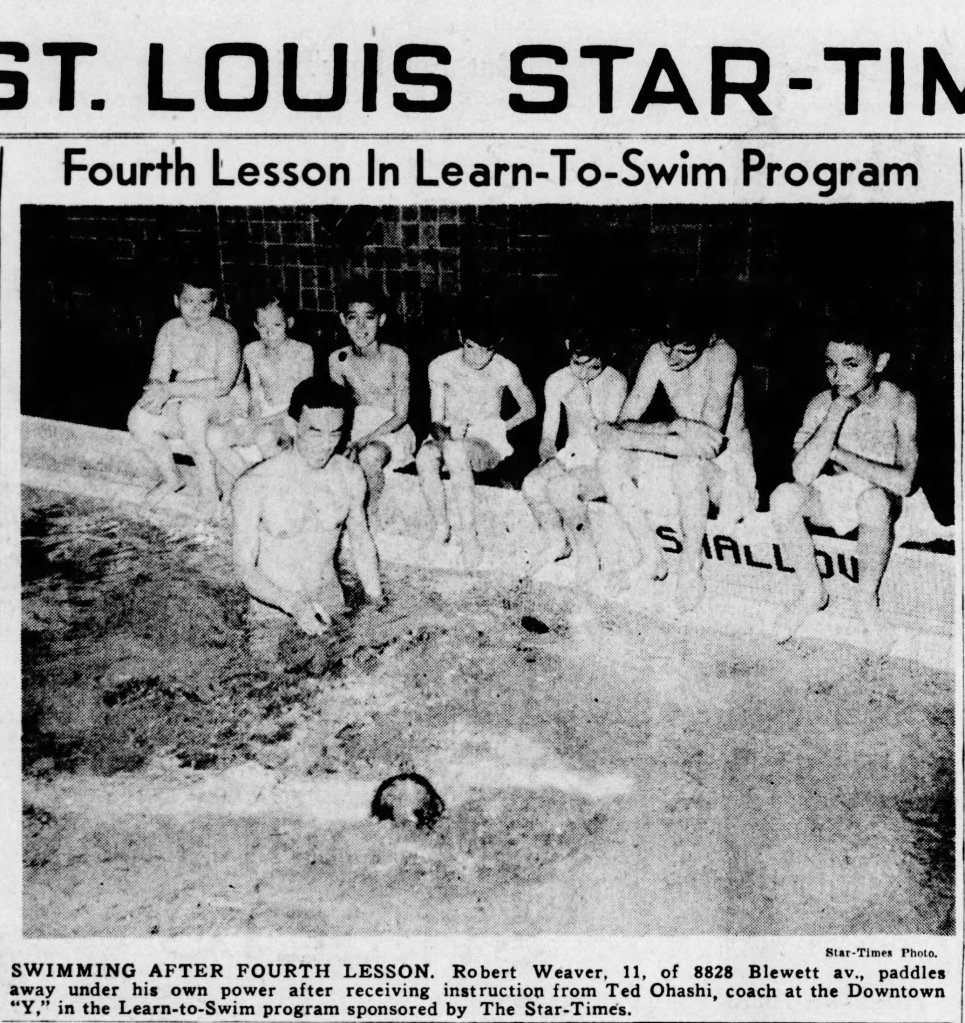
On June 24, 1947, the St. Louis Star-Times newspaper published a human-interest photo of the YMCA learn-to-swim class that they were sponsoring. As in previous images, the towels the boys draped over their laps render their condition suitable for a family publication.
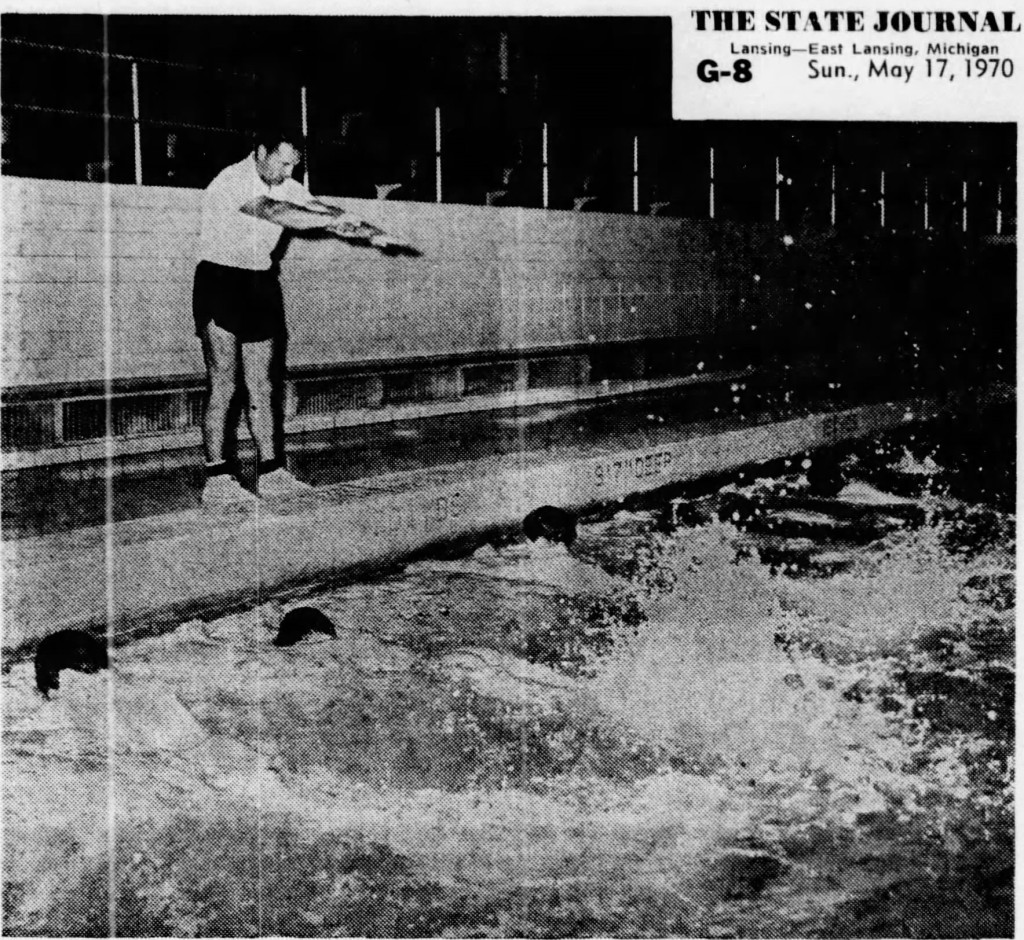
This this image from the Lansing, Michigan State Journal is a bit more revealing, showing a pair of bare buttocks during a kicking exercise. The curious thing is that the swimmer on the far left seems to have had his derrière modified in a clumsy attempt to impose some modesty. Why the swimmer to his right didn’t get that treatment remains a question. Noteworthy is the fact that swimming instruction was still conducted in the nude in 1970, at least in Lansing.
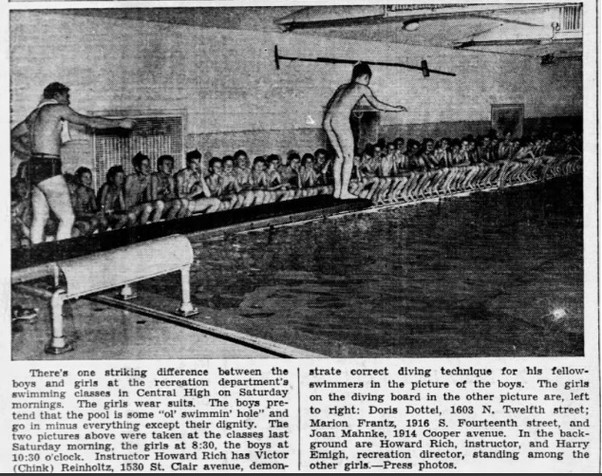
As long as we’re looking at newspaper articles about swimming classes, this might be the iconic image of its type. This item from a small town newspaper pulls no punches in its description of the goings on – them guys is nekkid. The boys are ranged around the pool in the classic knees-together pose, but the guy on the diving board (who is identified by both name and address) has nowhere to hide. Everybody in town saw his hind quarters.
For contrast, the companion image showed a group of girls in one-piece suits and bathing caps reclining in various attitudes as they posed for the camera. The caption was at pains to specify that the two groups did not mix: the girls at 8:30 AM, the boys at 10:30.
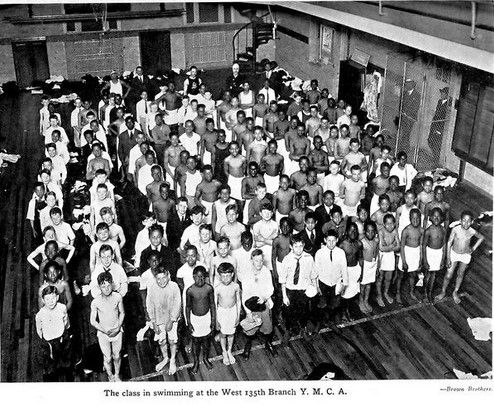
The embedded caption Indicates that this is a swimming class scene from the venerable Harlem YMCA in New York City. This particular “Y” dates from the 1910’s and still serves its community today. This image is dated August, 1921.
This is another example of a cover-up for a group photo except that it seems to have been caught in progress. While many of the mixed-race group are modestly swathed in towels, some remain in street clothes including dress shirts and ties. Clothes are strewn around the periphery of the room (apparently the gym, not the pool) as though the group had been interrupted in the process of disrobing and told to line up for the picture. That nude swimming is the intent is reinforced by the fact that there is not a pair of trunks in sight.
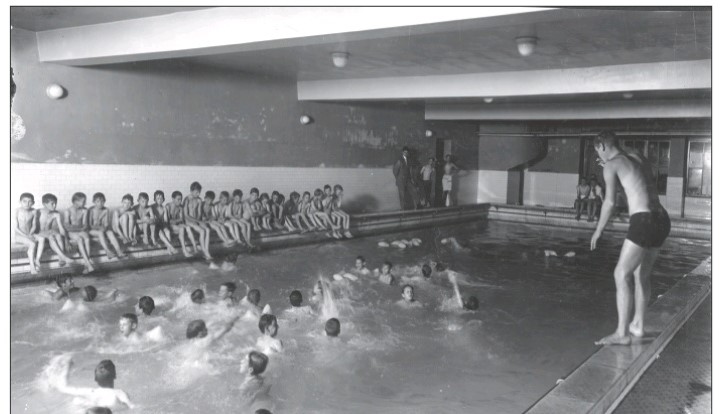
The geographical range of the practice of teaching boys to swim in the nude extended to Colorado. This old photo of a swim class was recently published in the Colorado Springs Gazette as part of a regular feature of historical pictures from the local area. It was supplied by the Pikes Peak Library District. It carries an approximate date of 1920.
As usual, the boys on the deck were instructed to keep those legs together. The older boys standing on the deck are wrapped in towels, which would be unnecessary if they were wearing swim suits.
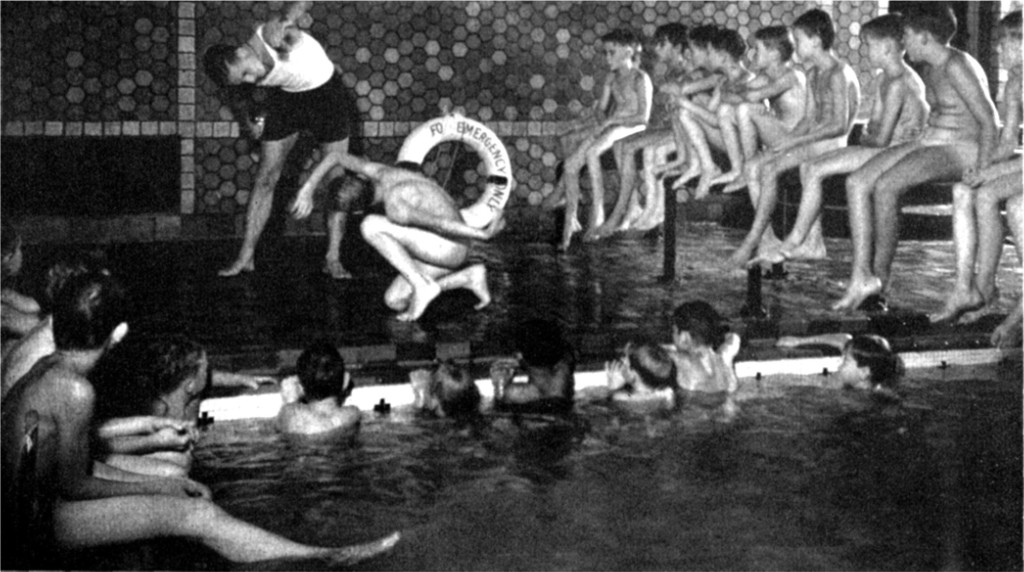
Speaking of geographical range, this photo is attributed to the Pasadena (I assume California) YMCA. It appeared in an article in a 1944 edition of the Journal of Health and Physical Education which discussed the wartime shortage of adult male instructors and monitors in the YMCA. The picture itself doesn’t make that point because of the adult instructor, so it is probably an archival photo that predates the article’s publication.
The composition of the picture is very well done, capturing an image of a large number of nude boys without giving anyone’s secrets away. The dry instructional technique is also interesting.
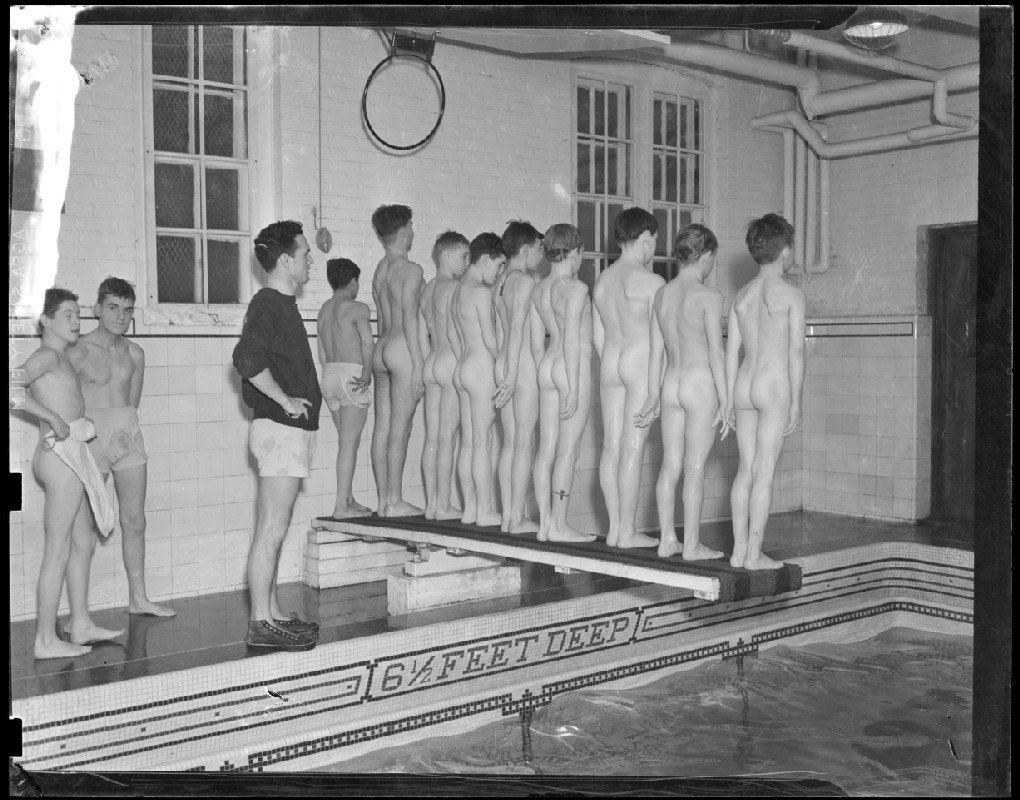
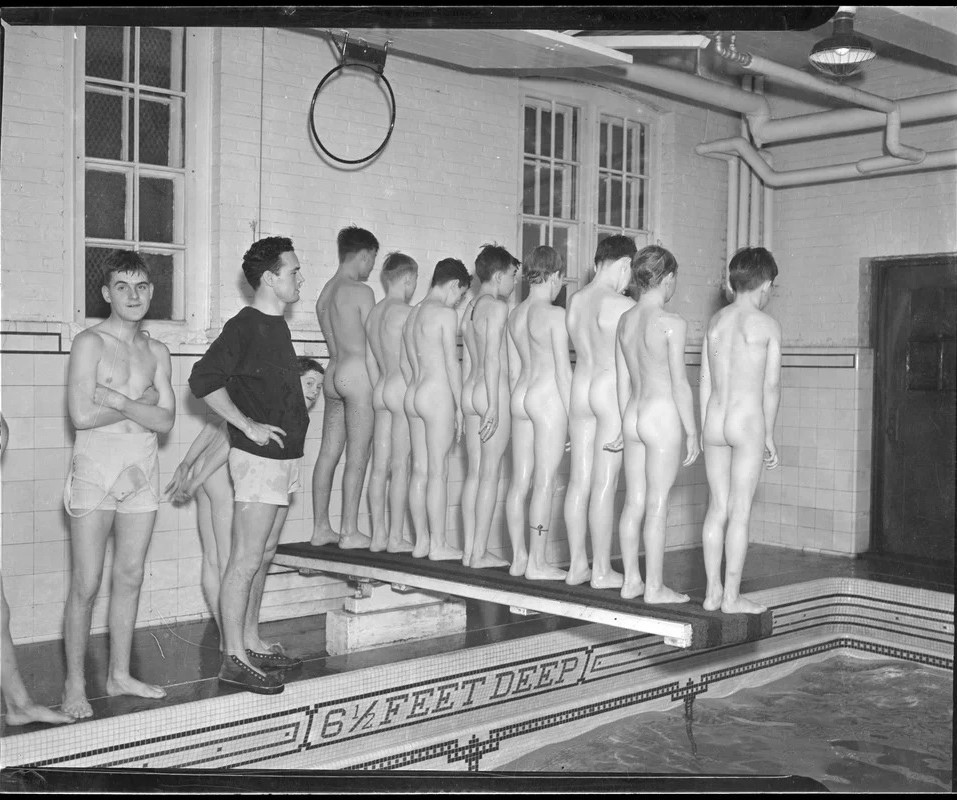
These two photos were taken from the Boston Public Library Arts Department archive dated 1934-56. Once again, we have a bunch of nude boys carefully positioned to keep penises out of view. The two versions of this posed scene were apparently taken minutes apart with a cast change in between. Note that the boy in the briefs in the first picture has disappeared, a new naked boy is peeking around the coach and the left side has been altered by cropping. Not sure what this is supposed to represent.
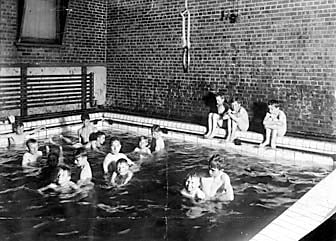
This photo of a swimming lesson that looks as though it is being held in a medieval dungeon is attributed to the Decatur (IL?) YMCA in 1910.
Of course, the boys on the deck are obeying instructions to hug their knees for the picture, but the boys in the water are paired off. I believe they are assisting each other in learning to swim by supporting their partners in an exercise. The pair in the left corner of the pool consists of a standing boy supporting his partner while the latter floats on his belly. The “support” boys may be older than the instructees.
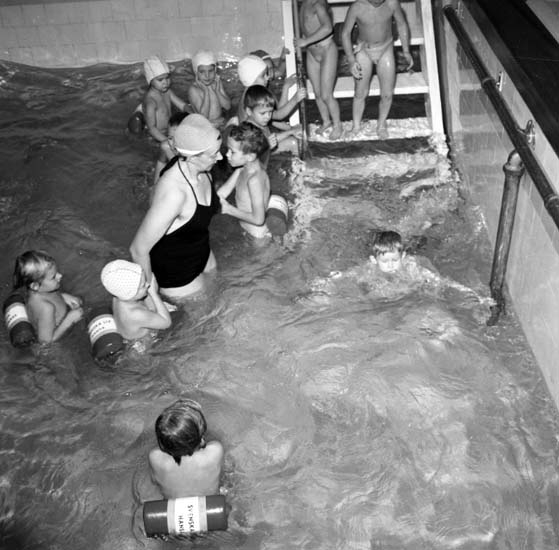
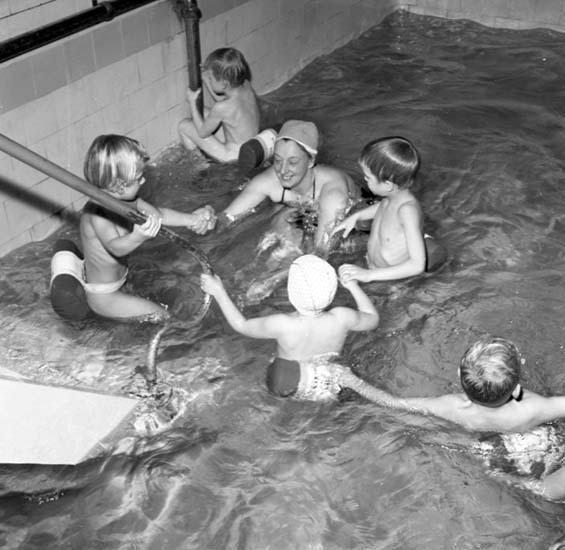
These images are from Sweden curtesy of our trusty Digital Museum archive. The originals reside in the Bohausland Museum and tagged with an unusually precise date of December 19, 1958. Although somewhat out of our main topic area, I am using it to pay homage to a hitherto unmentioned contributor to the cause of boys’ swimming instruction in the US – the YWCA.
The documentary evidence makes clear that recruiting suitable male instructors was a continuing challenge during our period of interest for the YMCA and similar non-profit organizations. Males simply had too many options for spending their time. Volunteering at the Y was probably far down the list.
Women and girls, on the other hand were relegated to fewer and less desirable roles in society. Couple that with the fact that teenaged girls mature sooner than boys makes them not only more available but also more suitable as instructors for young children. Since the YWCA had a ready pool of such talent, they took on the training of the youngest boys as well as girls in some locations. Truth be told, there are many instances in which both genders were trained in both types of Y’s. Also, male instructors were used at the YW’s and female teachers recruited for the YM’s. (There is an account of one man’s experience in a YWCA class in Historical Resources, the 3rd item under number 11.)
There seems to have been only two constants across the spectrum of this experience: the genders were segregated and the young boys participated in the nude. (As you can see, the Swedes did not insist on the “segregation” part, but they were completely in concert with the “nude” part.)
Now for the mother lode. This next group of images comes to us courtesy of the Illinois State Library and Office of the Secretary of State. The Illinois Digital Archive contains a collection of images recording the swimming training that occurred at the Bloomington Illinois YMCA in 1936 and 38.
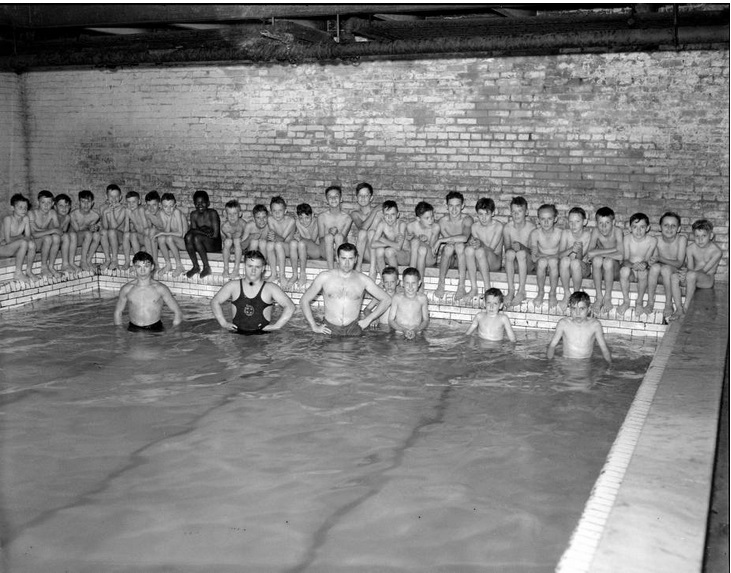
The instructor (in water, center) is assisted by two teenagers but still might be understaffed. The boys on the side are doing a pretty good job of keeping their knees together except for the taller boy just right of center who has his knees together but his ankles splayed. His grin tells you that he knows exactly what he’s doing.
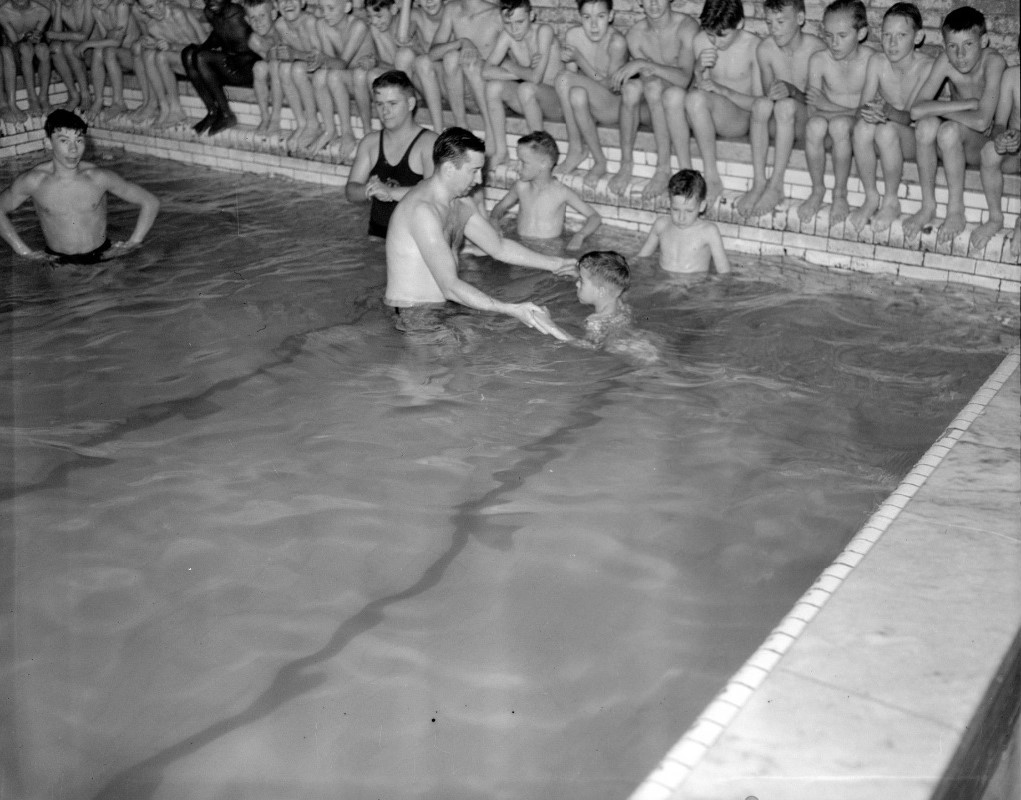
Class is now in session. Same crew a few minutes later.
A couple of years later on June 8, 1938 they took a looser approach to class photography as seen in this sequence of images.
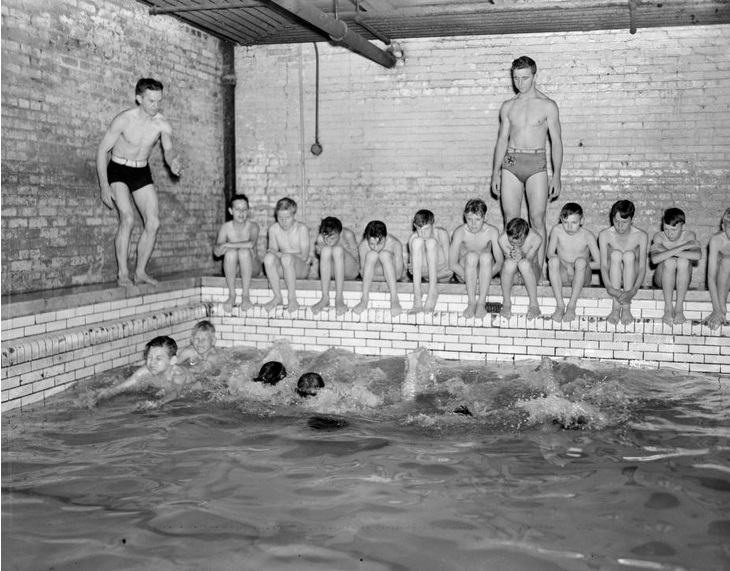
The first squadron of students takes off.
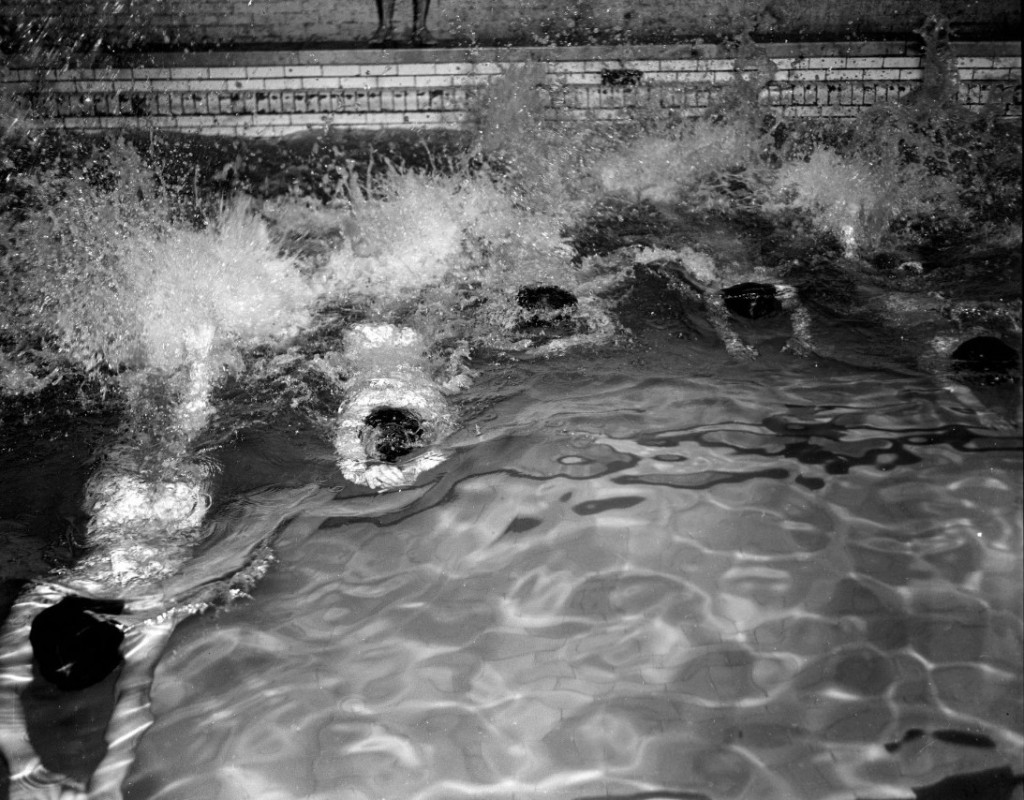
… and this is how it looked from another perspective.
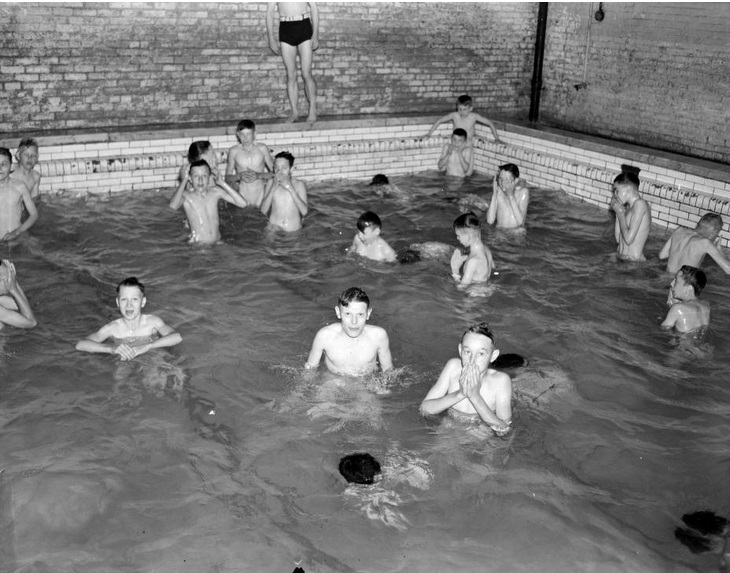
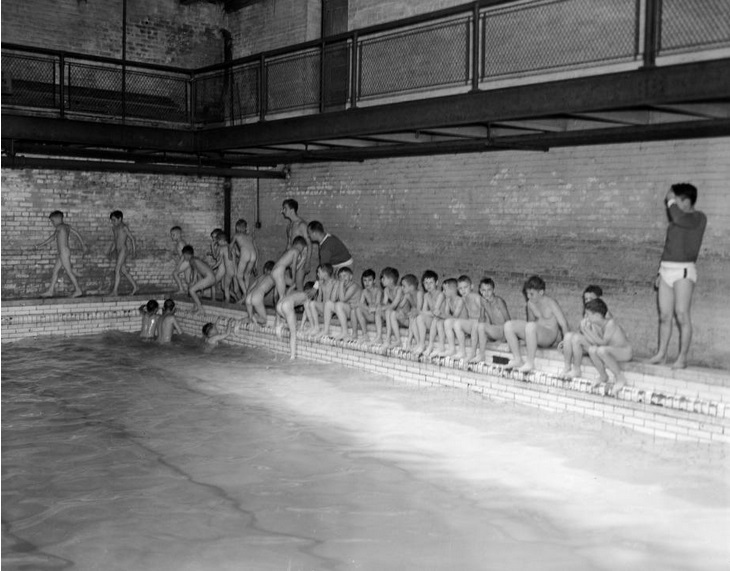
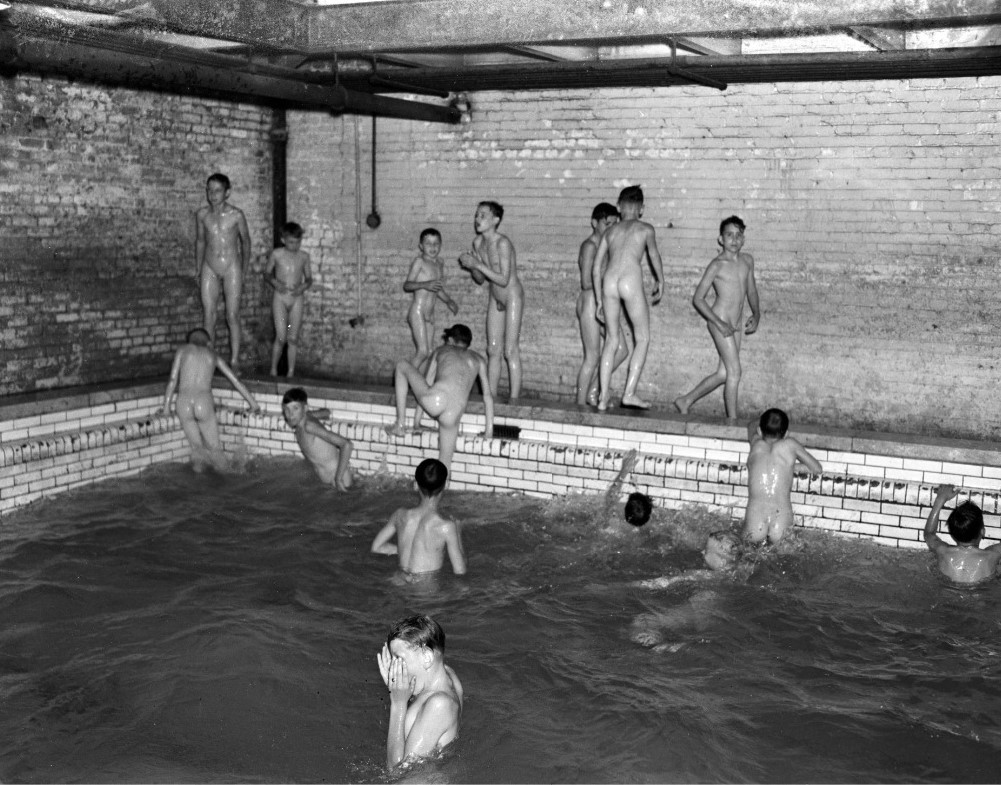
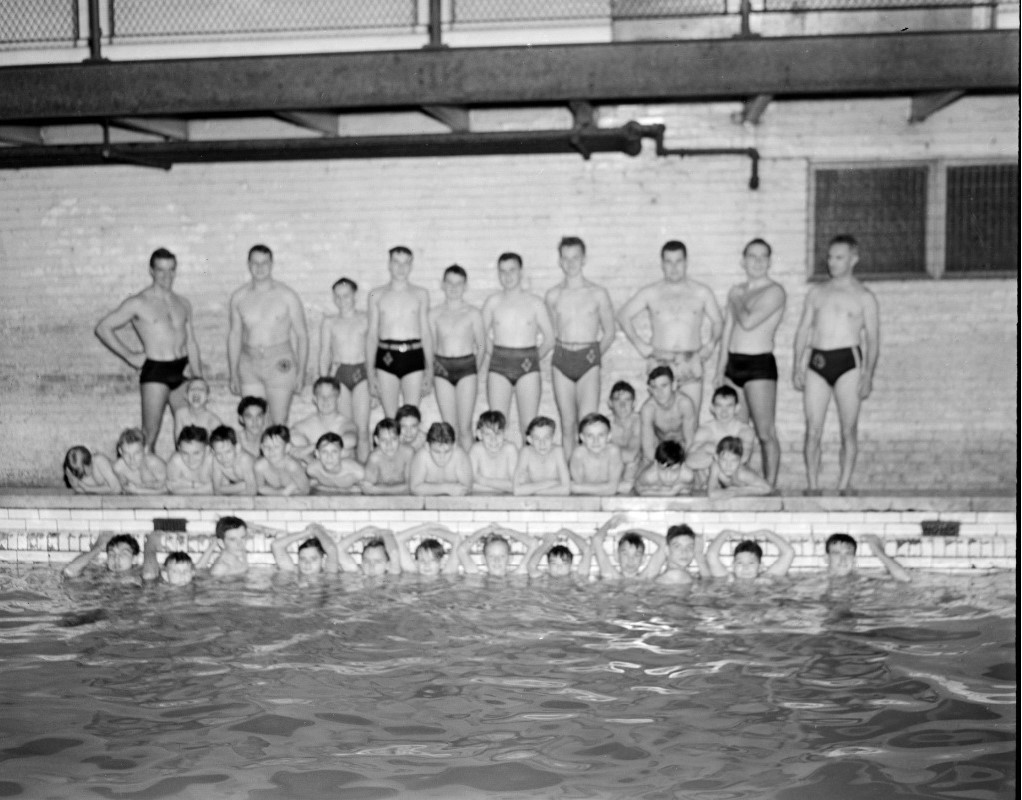
In that same period the Boy Scouts conducted Red Cross sanctioned life-saving courses at the pool. Their method for hiding penises from the camera was to either lie prone or hunker down so only the head was visible above the water.
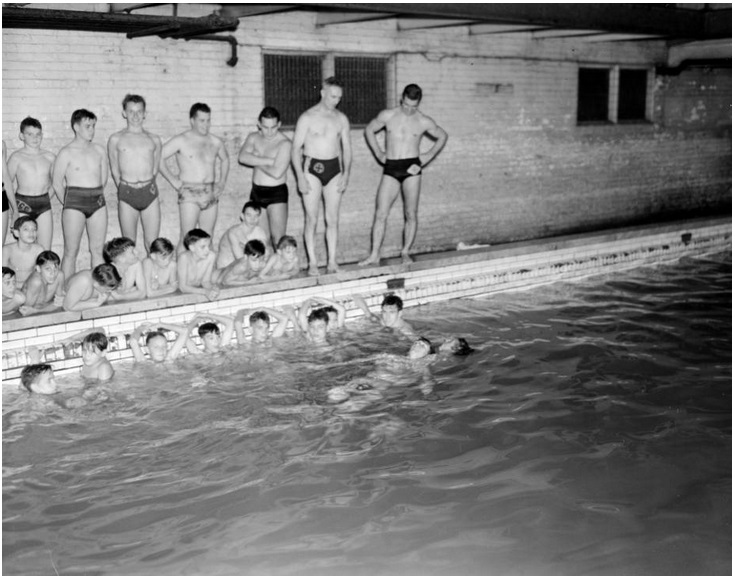
Every good scout knows that modesty has to take a back seat when lives are at stake. Oh, well, just guys.
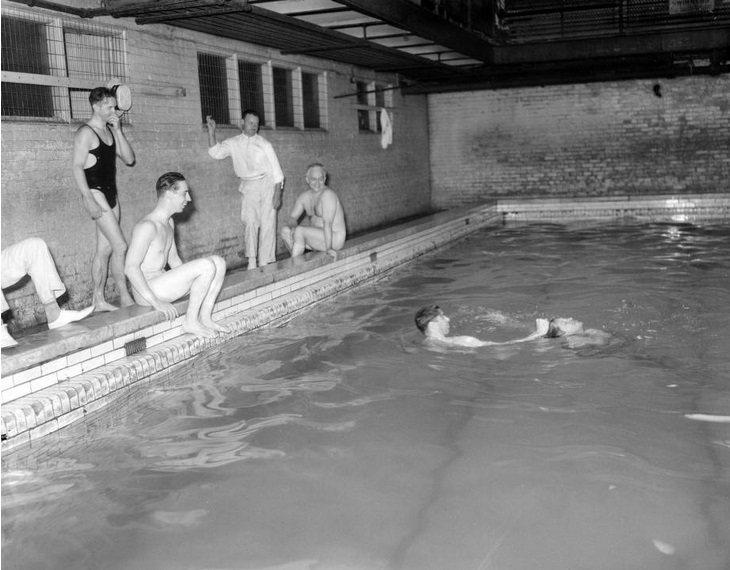
We’ve returned to 1936 for life guard training. This is an older crowd engaged in more advanced activities. Note that the naked guy sitting nearest the camera looks like the instructor in the earlier learn-to-swim shots.
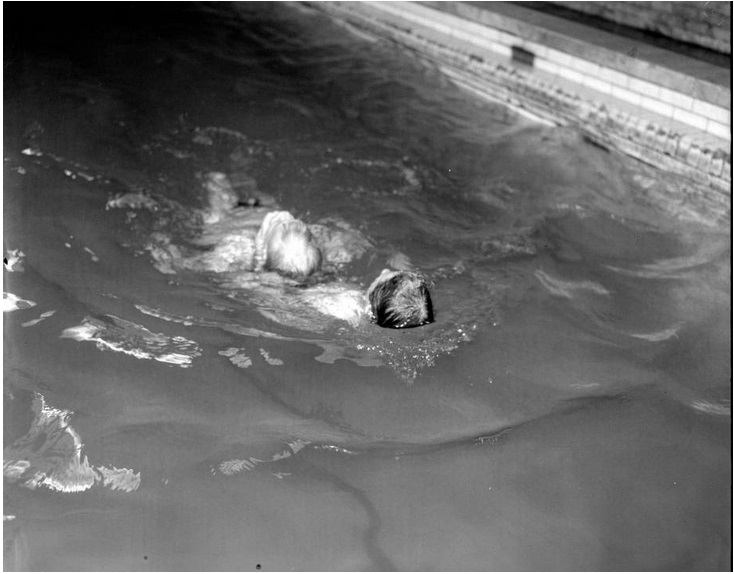
Once again, the exposure of the “victim” being towed to safety confirms the sartorial state of the participants.
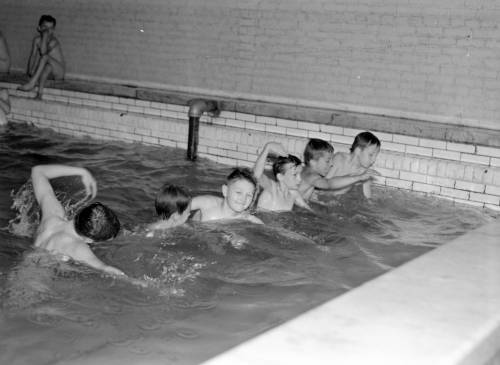
This standing stroke exercise occurred on June 12, 1942 in the same YMCA. Nothing seems to have changed since the 1930s. The uniform is still skin as evidenced by the lad on the deck visible in the upper left corner of the frame.
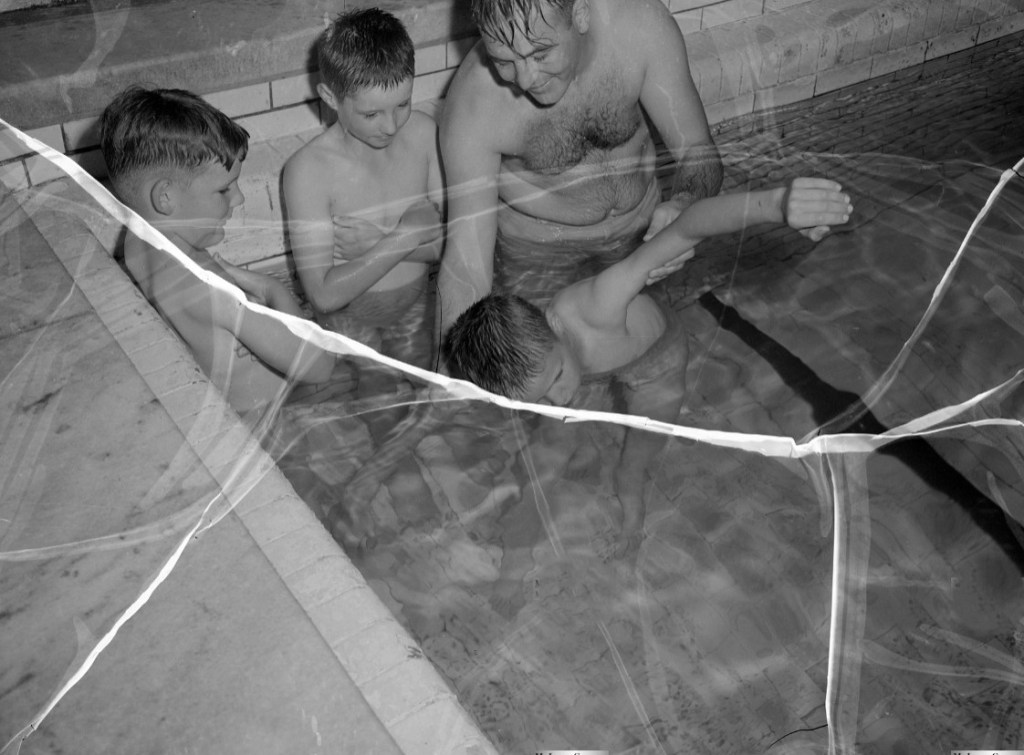
This mauled image is from the very same Bloomington YMCA in 1955. Its pedigree is from the Illinois Digital Archive which got it from the McClean County Library who archived it from the local newspaper, The Pantagraph’s negative collection. Talk about a chain of custody.
One wonders if this photo was published in the paper since the two boys facing the camera are plainly showing their penises through the crystal-clear water.

Bloomington was not the only YMCA to offer swimming lessons in Illinois. This 1947 photo shows class being held in a rather uninviting setting in what continues today as the Southwestern Illinois YMCA. No doubt that suits were not required here either.

We’re still in Illinois, Toto. This time it’s the YMCA in the northeast town of Elgin and the year is 1937. The guy in charge is Gordon Silvey according to the Courier-News whose negative collection this photo came from. Although this is supposed to be swim class, Mr. Silvey doesn’t seem to be insisting on strict attention.
The other unconventional thing about our man is that he doesn’t appear to be wearing a swim suit – just a short towel wrapped around his waist and tucked in. The length of thigh he’s exposing does seem to suggest that there’s nothing below the towel. In this period, the YMCA recommended that although nude swimming was normally the requirement, swim instructors should wear suits. One is left to ponder whether Gordon normally conducted the class while attired in his altogether and simply covered up for this newspaper photo.
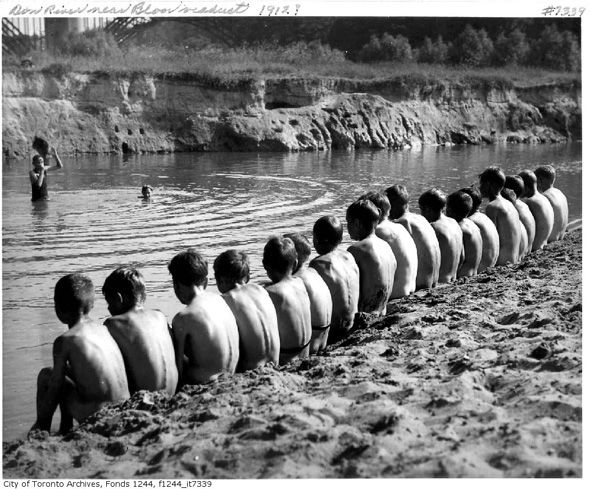
This is a rarity from north of the border. The tank-suited instructor is addressing his nude class members from the middle of the Don River. This is not the fabled Don that flows in Russia, but rather the stream near Toronto, Canada. The text inscribed on the edge of this image indicates that it was taken around 1912. It also indicates that this activity was affiliated with the YMCA.

Remarkably, the City of Toronto Archives also yielded this photo taken, like the previous image, on the banks of the Don River. It is dated 1909 – three years earlier – but makes no claim to being a swimming lesson scene. There is no evidence of an instructor but I can’t think of another reason why a group of naked boys would sit in a neat line on a river bank.
As long as we’ve made the trek north, let’s fast-forward a few decades and visit the city of Brantford, Ontario. Moving indoors, swim instruction is conducted under the watchful eye of the local newspaper, The Expositor.

This is a low-quality reproduction of the photo that appeared in the May 14, 1948 edition of the above-mentioned newspaper. The activity shown was described as “getting used to the water.” Be that as it may, it resulted in a fine line of butt cracks being presented to the camera and, hence, to the general public. Look, Ma, no suit.

The tradition of teaching water safety continued in what was apparently the same venue as recorded in the July 7, 1951 issue of the paper. Your attention is drawn to the upper right corner of this image where two of the students have hauled themselves up sufficiently clear of the water to dispel any doubts regarding the nudity of the participants. Thanks, fellas.

Poking into another corner of the British Empire, this is a “public school” swimming class in Nuriootpa, South Australia. The year is 1924 and the venue is described as a “creek.” In American parlance, this institution would be considered a private school, since it charges fees to attend. So these boys in an upscale educational setting are getting their aquatic instruction in a crag-filled creek. Crocs, anyone?
This photo is sourced from the State Library of South Australia archives.

This image has all of the right elements: an organized aquatic event involving young boys not wearing swim suits. However, it is completely unattributed as to time, place or topic. Good stuff. Let’s dig in.
I’ll start by guessing that this is a European lake beach. The stoney nature of the beach surface is usually not typical of the corresponding American setting. Such a venue would have been covered with trucked-in sand in the States.
There are several clues for dating. The partially obscured car in the background is no help. It is the configuration adopted for popular (that is, economical) car models for decades in Europe. More helpful is the Volkswagen minibus/camper on the left side. Although the minibus (it went by various names) was first manufactured in 1950, the camper did not appear until around 1970. It was produced throughout the 1970s (and later) with various pop-up configurations. The forward-sloping pop-up here was among the earliest models.
Looking at the young participants, some are wearing bucket-shaped sun hats. My personal recollection is that these were not around much before the 1970s. More definitive is the full-grown female on the right edge of the image. She seems to be wearing split-side running shorts. These came into vogue in the … you guessed it … 1970s.
As to the event that brought together this crowd of adults and children, we’ve got two choices: instruction or entertainment. The older gentleman who seems to be the focus of attention looks like neither. We’ll probably have to let this remain a mystery.
That unresolved point, however, cannot detract from the novelty of a mixed boy-girl group in which some of the boys (distinctly in the lower right corner) are nude with tolerant/approving adults present.
Although this page was about learning-to-swim classes, we began with a non-instructional image. We may as well bookend our posting with another of the same.
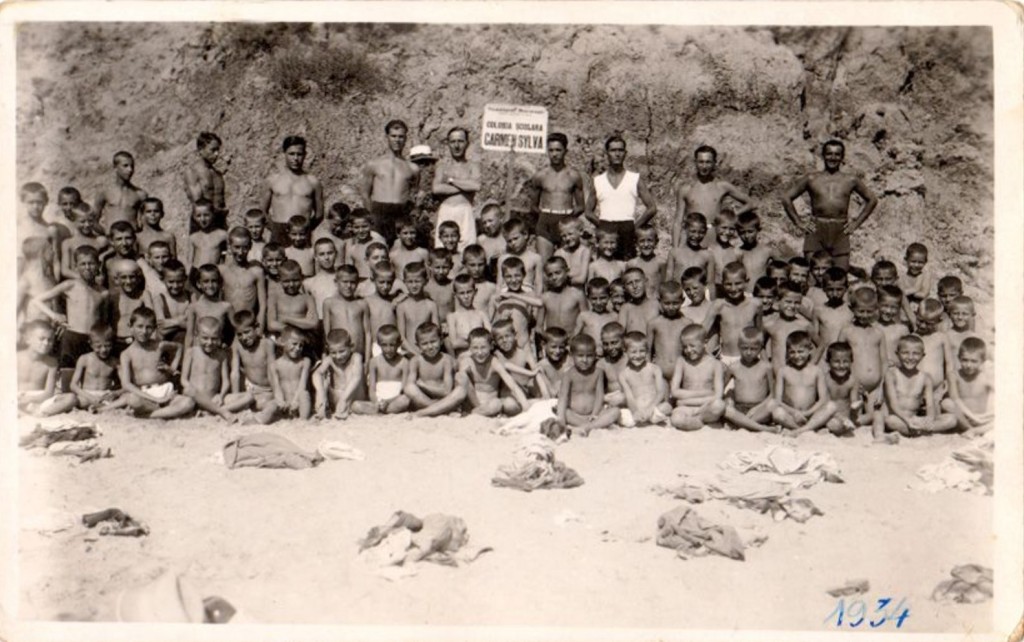
This is a school class outing that occurred in Romania in 1934. As you can see, some boys had swim suits and some (the majority?) did not. The people in charge took the trouble to prepare a placard with the school name, but the event wound up being recorded in this haphazard fashion. Besides the clothing strewn around in the foreground, nobody took the trouble to make sure the naked boys were modestly posed. Consequently, there are multiple pre-pubescent wieners on display. Apparently, no one thought to take a second shot so that the boy on the far left who is turning away from the camera would have a chance to recover.
The interesting anecdote is that this photo was printed on a postcard. Apparently, it was considered fit for free distribution through the mail.
That’s a wrap on swimming training. For the next posting, I will sweep out the corners of my photo bin and present some none-of-the-above images.